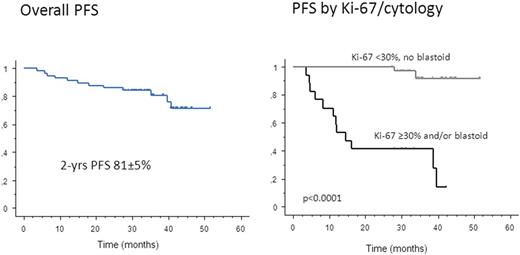Abstract

Background: The combination of rituximab (R, 375 mg/m2 intravenously [IV], day 1), bendamustine (B, 70 mg/m2IV, days 2 and 3), and cytarabine (800 mg/m2, IV on days 2 to 4) was highly active in patients with mantle-cell lymphoma (MCL) in a phase 2 study [R-BAC; Visco et al, JCO 2013]. This regimen was well tolerated, but hematologic toxicity was quite relevant, especially in terms of transient grade 3 to 4 thrombocytopenia (76% of cycles). Aiming at reducing hematologic toxicity, the Fondazione Italiana Linfomi (FIL) designed a phase 2 trial adopting the R-BAC schedule, but lowering cytarabine dose to 500 mg/m2 (RBAC500).
Materials and Methods: Patients with newly diagnosed MCL, aged 61 to 80 years, not eligible for autologous transplant and fit according to the comprehensive geriatric assessment, were enrolled. Patients presenting with non-nodal leukemic disease were excluded. The primary endpoints were complete remission rate (CR) measured by FDG-PET according to Cheson criteria 2007, and safety. Secondary endpoints included rate of molecular response (MR) by nested-PCR using patient specific IGH or BCL1 based targets, progression-free (PFS) and overall survival (OS). The study was conducted according to the Bryant and Day two-stage design.
Results: From May 2012 to February 2014, 57 patients with MCL from 29 centers were recruited and treated. Central pathology revision was performed in 87% of cases. Median age was 71 years (range 61-79), 75% were males, and 91% had Ann Arbor stage III/IV disease. Mantle Cell International Prognostic Index (MIPI) was low in 15%, intermediate in 40%, high in 45%, Ki-67 was ≥30% in 31%, and 9% had the blastoid cytological variant. Overall, 53 patients (91%) received at least 4 cycles, while 36 (63%) had 6 cycles (median 5.3 cycles per patient). Fifteen patients (26%) discontinued treatment before reaching cycle 6 because of toxicity/adverse events, that mainly consisted of prolonged hemato-toxicity between cycles. Only one patient discontinued due to progressive disease. Grade 3 or 4 neutropenia and thrombocytopenia were observed in 49% and 52% of administered cycles, respectively. Febrile neutropenia occurred in 6% of cycles. Extra-hematologic toxicity was mainly cardiac (5%). Overall response rate was 96%, and CR was 93%. The MR rate at the end of treatment was 76% on peripheral blood and 55% on bone marrow (BM) samples. With a median follow-up of 34 months (28-52), the 2-years PFS (± confidence interval) was 81%±5% and the OS 85%±4%. Elevated Ki-67 (≥30%), and the blastoid variant were the strongest independent predictors of adverse PFS. Patients with either of these two features (33%), had a significantly inferior PFS (41% vs 97% after 34 months) compared to patients with classical/pleomorphic variants and low proliferative index (p<0.0001, Figure 1).
Conclusions: The R-BAC500 regimen can be safely administered as first line therapy to elderly patients with MCL. Hematologic toxicity is substantially reduced compared to our previous experience. With 93% of FDG-PET negative CR, and a 2-years PFS of 81% without maintenance therapy, the R-BAC500 regimen is a highly effective treatment for patients with MCL, and compares favourably with previously reported regimens in this patient population, including R-bendamustine.
Visco:Gilead: Speakers Bureau; Lundbeck: Consultancy; Mundipharma: Research Funding; Celgene: Speakers Bureau. Spina:Mundipharma: Membership on an entity's Board of Directors or advisory committees, Other: Speaker Fee; Teva Pharmaceuticals Industries: Membership on an entity's Board of Directors or advisory committees, Other: Speaker Fee. Di Rocco:Celgene: Honoraria. Carella:Millenium: Speakers Bureau; Genentech: Speakers Bureau. Vitolo:Roche: Membership on an entity's Board of Directors or advisory committees, Speakers Bureau; Janssen: Honoraria, Membership on an entity's Board of Directors or advisory committees; Takeda: Honoraria; Gilead: Honoraria; Celgene: Honoraria.
Author notes
Asterisk with author names denotes non-ASH members.

This icon denotes a clinically relevant abstract


This feature is available to Subscribers Only
Sign In or Create an Account Close Modal